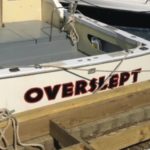Cummins Marine Diesel Repower Specialists › Forums › Cummins Marine Engines › 160° Thermostats in a 6B: What is normal behavior?
- This topic has 17 replies, 8 voices, and was last updated 2 years ago by
 Tony Athens.
Tony Athens.
-
CreatorTopic
-
May 24, 2021 at 5:56 am #115442
Twin 6bta 370’s, 1996 manufacture date, 1600 hours.
I was battling engine temps that were creeping to 195°F last season. So this offseason I took off heat exchangers, aftercoolers, gear coolers (fuel coolers were deep-sixed), rodded, acid washed, new gaskets/orings etc. There was some significant blockages in the heat exchangers around the zincs. I also decided to swap to 160°F thermostats so I wouldn’t spend 50% of my time staring at the temp gauges looking for an overheat. Also replaced the port raw water pump with an smx. New impeller in the starboard sherwood pump that was rebuilt ~800 hours ago (planning on replacing this one next winter).
Boat is now back in the water and running great but I’m a bit surprised at the temps. Idling out to open water I used to hit 180°F and see them sit there at 180°F, which of course makes sense (about 15 minutes to open water). Now they climb (much more slowly) to 140°F and stay there at 140°F—which surprised me. Up on plane they climb to 150/160°F (port/starboard). WOT they run 160/170°F (p/s) at about 3075rpm/30.5 knots. After pushing them hard like that, the temp then seemed to stay at 160/160 when idling into the harbor. Next time out, same thing…they warm to 140°F and no more when idling.
I have two questions:
–Is the behavior of climbing to 140°F and stopping there normal for the 160°F t-stats? I was expecting them to get to 160°F.-I feel great about the WOT temps (below 180°F) but hate that the two engines don’t match. I wonder if this could be an smx vs sherwood thing (or new pump/pump cam vs old thing)? Another difference between the engines is that the starboard engine coolant circuit includes the hot water heater for the boat’s freshwater supply. I have always thought I should eliminate that extra loop…the hot water heats up plenty fast with the electric element when needed. Just seems like an extra failure point. Anybody have thoughts on if one of these two things could cause the temp difference between the engines? I’m leaning towards ‘be happy they’re running so cool and go fishing’…
-
CreatorTopic
-
AuthorReplies
-
May 25, 2021 at 7:04 pm #115567

Tony AthensModeratorVessel Name: Local Banks
Engines: QSB 6.7 550 HP
Location: Oxnard, CA
Country: USA
For JimmyK,
My thoughts on all of this go like this…..
We spent a coupe of years trying to come up with a thermostat that gave the B more protection & time to respond to any over heat issue….This is what we came up with as a best compromise ..
Sure, I’d like the engine to heat to 180F at fast as possible and then have thermostat that was so “variable” that if the temp went to 181-185f it world bring the temp right back down…………………When you find one that will do that, I am all in………………….. And, last, every engine is different because of all the variables in the installation..
May 25, 2021 at 6:06 pm #115564
Francis ValerioParticipantVessel Name: overslept
Engines: Twin 4BT CPL741
Location: Massapequa Park, New York Long Island
Country: USA
When you are idling and the thermostat is closed DO you think that 100% of the coolant is stopped by the thermostat?
There is a coolant by-pass in the system (it is clearly shown in the pic I attached from a Cummin manual) that is OPEN when the thermostat is CLOSED…Are you aware of that??? (Jimmy)
This passage is “OPENED” when the thermostat is “CLOSED”, this passage then “CLOSES” when the thermostat “OPENS”.
I will be honest and say that I do not know exactly what the purpose is for this “by-pass passage” or where exactly the by-passed coolant goes in the coolant system.With that said this “much smaller” passageway I would think that it by-passes the thermostat (obviously) and allows for quicker warming of the cooling system by allowing some coolant to flow thru the system.
I believe that the unforeseen consequence of this is that it also will work to cool the system faster as the “load” is taken off and coolant temp starts to recede. This is just a guess but even though Jimmy is a little condescending I will stiil try to help him out with the scientific explanation that he is so in need of and to continue the conversation since he is an information junkie.A different example of a by-pass situation:
I do have a coolant by-pass on my 454 LS6 (automotive) that I rebuilt a few times over the decades that serves a purpose like this (and in that case it is to assure the head stays more uniformly cool or warmed as the car warms up).For the record when I had my OEM Cummins Thermostats (not aftermarket) I would NEVER reach operating temperature unless I ran under load (prob over 1200+ but in gear).
When I have to go thru the 5 mph zones my engines drop to 140F (or lower) They ALSO did this with the 180F thermostats.
The only difference now is that I stay around 160F-170F when running at cruise or higher (because of the 160F thermostats
If someone could clarify the coolant by-pass and how it works it would be appreciated.
1 user thanked author for this post.
May 25, 2021 at 5:29 pm #115559
Rob SchepisForum ModeratorVessel Name: Tenacious
Engines: 6BTA 5.9 330's - "Seaboard Style"
Location: Long Island, NY
Country: USA
Tony’s post is basically right on as to what I see. I have a loooong creek ride at 600-650rpms / ~5knots and they get somewhere midway between the 100 and 150 but I never really looked at the needle straight on to narrow it down. Once I get into the bay I push her to 1,200 or so to get some load on her to get them flowing and then after a minute or two I’ll bring her up to cruise and she get’s up to temp. On the way back in during the 650rpm creek ride she’ll stay up over the 150 mark like Tony mentioned in his #3.
1 user thanked author for this post.
May 25, 2021 at 2:36 pm #115553
William WalterParticipantVessel Name: Positive rate
Engines: Cummings 480ce
Location: Long island
Country: Usa
160 thermostat
On my 480 ce I have 160 stats that run kind of like Tony said. I get to about 130-140 as I leave harbor then as I apply power they seem to overshoot my normal temps of 162-163 by about 4 degrees then back right down to 162-163.I may run a degree on either side depending on sea temperatures. I tried like hell one time to get the thermostats to open at dock because I was replacing antifreeze but still couldn’t .Had to get it under load to do that.on a prior boat tried to heat up hot water heater on a mooring because I didn’t have a generator but that never worked either unless I got under load.also my white smoke doesn’t go away till I’m up to full temperature..Just my norms if it helps anyone.
May 25, 2021 at 2:16 pm #115551Thanks for the reply, I appreciate the info. It seems like you’re suggesting the cooling that is clearly happening below 160F is a result of coolant going through the small bleed hole (I did notice the lack of jiggle pin).
I will admit that it strikes me as hard to believe that there is any type of significant flow through a 3/32″ hole as I mentioned in my second post but I have not run the numbers at this point, so I’m not taking a hard stance. It seems more likely that the stat is beginning to open based on the climb, climb, climb, stop right at 140 behavior. I am an information junkie so I’m tempted to buy a ‘spare’ and test it in a hot water bath with a thermocouple and scale and generate a temp vs displacement curve.
Regardless of all that, the important points are that it is normal for cooling/flow through/by the stat at temps below 160 and what I’m seeing seems typical. More over, it would appear that I’m in a much better place at cruise with way more room for error, which was the point of the exercise. thanks.
May 25, 2021 at 12:41 pm #115537
Tony AthensModeratorVessel Name: Local Banks
Engines: QSB 6.7 550 HP
Location: Oxnard, CA
Country: USA
Normal behavior of our Hi-flow 160F thermostats? Think everything is 20F lower (or a tad more than the stock 180/185’s)
Engines do vary, but in general this is what we experienced in the testing we did about 8-10 yrs ago. But since then, I’d says the best answers are going to come from the 100’s of vessel owners that have installed them.
1) At low rpm’s (IN GEAR) such as idle up to 1000 RPM or so, they reach about 140-150-ish and tend to stabilize ( just like all the newer Q-engines do with 160F stats..) Why they do that is because of the 3/32″ diameter “air bleed” hole we put in them. This is why we never get air locks when filling. Never trusted the “jiggle pins”.
2) They rarely come up to temp until you get above 1400 RPM. So once at 130-140F, hopefully you can you move the throttle up some
3) Cruising at higher RPM’s are typically below 170-175F-ish if all the rest is 100%. When you back down on a kelp paddy or something, dropping down to 150-160 is common.
4) engines with an external coolant heater typically run cooler and take longer to get to temp–Your “externally heater/water heater” is just another Heat-X.
5) Where did “Hi-flow” come from? When temp gets to 175-180 ish, they open-up way more than the factory stats, hence the term “Hi-flow”, and things cool back down quick.. But again, every set-up is different just like with stock stats.
All this being said by me is not the best answer. The best answer come from the guys that have bought well over 500 of these stats over the years. To us, these stats solved all the past issues that I used to spend way too much time on years back when I was hanging out on “boatdiesel”. In those days, even the factory could not figure out what stat they liked in the marine B’s.
May 25, 2021 at 6:56 am #115512Edwin, thanks much for your input. It seems your t-stats are indeed starting to open at 160 which would be normal behavior for a 160 labeled t-stat. And, hence, your steady steady idle temps are…160, as one would expect. It appears Francis and I have t-stats that behave like ‘140’ t-stats which is peculiar. I appreciate the additional detail you provided about your cruise temps and how they depend on the seawater temperature. This is useful information for me. Could you tell me how old your t-stats are? I wonder if there has been a change to them over the years or if perhaps the latest lot are behaving differently than previous version.
Francis, if you’ve taken my comments to mean I’m suggesting you should idle for long periods of time, I’m really not sure what to say except that my comments went way way over your head. I was using the description of what WOULD happen if you idled for long periods of time to illustrate the typical behavior of a cooling system, not to suggest what you should do on a normal basis. At the core of your misunderstanding is this strange belief that the engine cannot achieve 160°F unless it’s under load even with the thermostat closed. This, frankly, is completely ridiculous. You and I both have thermostats that normally would be described as ‘140°F thermostats’ as evidenced by their steady state temperature at no or very low (trolling) loads being at 140°F. Edwin’s description of his steady state temperature at no or very low loads (160°F) is typical of a thermostat that is described as ‘160’. It strikes as odd that you refuse to understand this…it is very very simple.
Just focus on this:
Your thermostats are starting to open at 140 as are mine. This is a fact based on the evidence that you & I provided. This is not typical behavior for thermostats labeled as 160.May 25, 2021 at 6:05 am #115509Jimmy –
my experience with the sbmar 160deg thermostat in my 6BTA 250hp is that it starts to open at 160 and will settle there at no-wake speeds (“idle-under-load”) either during warmup or after coming off plane. At cruise speeds it’ll go to 175-180deg depending on the water temperature, which means the tstat is fully open and I’m running at the limit of the cooling system when Chesapeake Bay temps reach 85+ in the summer. (the 6B250s had 1.5″ raw water plumbing and not a lot of margin, plus my raw water side is due for a cleaning.)
Francis is correct- extended idling at the dock is to be avoided, but many of us spend lots of time at trolling or no-wake speeds. All thermostats I’ve installed seem to settle around the rated ‘opening’ temp at 650-900rpm. BTW, I’ve found that t-stats of even the same make & rating can respond very differently, but both of yours seem to be consistent.
May 25, 2021 at 5:23 am #115506
Francis ValerioParticipantVessel Name: overslept
Engines: Twin 4BT CPL741
Location: Massapequa Park, New York Long Island
Country: USA
Jimmy
Cummin B-series is NOT designed to idle more than a few minutes as per the Cummin manual (3-5 minutes to be exact).
The reason is that the combustion temperatures will not create enough heat to properly burn the fuel. Attached is from the B-Series manual. I dont have the scientific explanation (I say that sincerely) but I have been a Cummins owner for many years and I have read the manual cover to cover many many times.
There is a ton of information on here about operating temperature and load. Search it and there may be an actual explanation that you are looking for.
Operating temperature and coolant temperature are not exactly the same thing, with that said operating temperature is when the “OIL” has reached its operating temperature and that is NOT possible with a “PROPERLY” running engine and properly maintained cooling system.
As per Cummins, Any B-Series engines are not to be warmed up for more than a few minutes. Therefore it is not possible or advised to even try to warm it up. With that said, I have done it and if I do I would bring the idle upto about 1200 if I was to try and bring the temps up at the dock.
I will also attach the coolant flow diagram from the Cummins manual. Take note of #5 “coolant bypass passage”. This possibly will give a partial explanation of the “why” you ask.
Jimmy, I assure you that I carefully make statements on this forum and try very hard to give accurate information. This forum has helped me tremendously and this is the “giving back to the community” part. With that said every statement I made in this post is accurate.
1 user thanked author for this post.
May 25, 2021 at 4:33 am #115505Hi Francis, thanks for the reply. I appreciate the back & forth and please don’t take this response as less than cordial.
With that said, I think it is you who is misunderstanding what’s going on. Think about it…you start your ‘cold’ engine and it starts producing heat. This heat warms the pistons, block, oil, coolant, etc etc. Even when tied to the dock the temp starts rising. 100, 110, 120, etc. Hotter and hotter if you were to let it sit there and idle even with absolutely no load. After a good while, when it gets to 140…it just stops getting hotter. Why? I mean the engine is still producing heat, of course. Where is the heat going? To the air in the engine room? Only a tiny fraction. So why does it heat up, up, up and then just magically stop at 140 (just like mine!)? Because something changes at 140…the TEMP stabilizes or becomes STATIC (THERMO-STAT). At 140 your thermostat is OPENING and allowing the hot (140°F) coolant flow through the heat exchanger and transfer heat through the bundle and into the cool seawater and then the heat goes out the exhaust with this slightly warmed seawater. THAT is why you idle at 140–the same as me! If you put thermostats that didn’t start opening until 180, guess what your steady-state idle temperature would be? 180!!!! Even at the dock with no load!!! Yes it might take a good while to get there but it would get there for sure. Practically speaking there is nowhere else for the heat to go. Now what if you replaced your thermostat with a solid piece of metal that blocked all flow? You really think you’d still idle steady-state at 140?! Of course not! The 140 steady-state temp is a function of the thermostat behavior.
I don’t get why when I asked about idling at a steady-state 140°F you told me to check my gauges? Seems like the better response would have been “I have the 160 t-stats and idle steady state at 140°F as well so it seems like it might be typical.” You eventually shared that info which I find very informative so thanks for that.
Obviously I’m very pleased by the idea that I can run at full load/WOT/3000+rpm and not touch even 180°F. Cruising at 160°F (or below) is going to give me great peace of mind and getting the engine temps down at cruise was the whole point–so overall I’m very happy with what I see so far.
I just like to understand things as completely as possible and the 140°F idling temps have me scratching my head a little. I have only heard the idling temps of 2 boats with these stats in them (yours and mine) and they both idle steady-state at 140. Magical coincidence? No, definitely not. I would love to hear from Tony if this is by design or not…some detail on what the intended operation of the t-stat is. I have noticed that these rambling threads (yes I’m very guilty) don’t get the involvement so if we don’t get an answer I will post a different, much simpler thread to try to get the answer to the question “What is the typical steady-state temp of a 6BTA with a SBMAR 160° t-stat at idle, cruise, and WOT under load?”
May 24, 2021 at 8:12 pm #115496
Francis ValerioParticipantVessel Name: overslept
Engines: Twin 4BT CPL741
Location: Massapequa Park, New York Long Island
Country: USA
I dont know what part you are not understanding about your situation
From what you have stated you were able to start your engines cold and reach 180F idling without putting the boat under a load. When loading the engines you were creeping to the 195F range.
That sounds like you had cooling issues…
Now you have installed 160F thermostats AND did all kinds of productive maintenance and also replaced some very critical components of your cooling system and your gauges are reading much cooler than before.
Maybe your engines are now running the way they are supposed to and you CAN NOT reach operating temperature at the dock idling like you used to.
That is the point I was and am continuing to make
May 24, 2021 at 3:46 pm #115486Francis Valerio said “If the engine is overheating when idling then the cooling system is not working properly.”
I totally agree with you and this contradicts your earlier statement that the engines do not even produce enough heat to run at 160 at idle. This just isn’t true. If your engine idles ‘steady state’ at 140 then coolant is getting by/through the thermostat at that temperature, as it is in mine, or you’re boating in the arctic circle. I don’t follow you at all when you say you can’t get an engine to operating temperature at idle…of course you can.
Gene Fuller said “The usual definition for the “temperature rating” of a thermostat is the point at which it *starts* to open, plus or minus a couple of degrees. The thermostat will be fully open 15 to 20 degrees higher than the rated temperature.
If you are seeing 140 degrees with a 160 degree thermostat it means one or more of these conditions.
* The temperature gauge is correct and the thermostat is not open at all.
* The temperature gauge is faulty.
* The thermostat is faulty.”
I totally agree with how you describe the ‘usual’ operation of a thermostat which is why I’m surprised that it climbs to 140 at idle…and stops (although I would say the transition typically happens over ~10°F rather than 20°F). I remember boiling thermostats in the past to make sure they were opening and at what temperature and it happened over a pretty tight temp range although this is dependent on how the t-stat is designed so I’m sure there are plenty of different profiles.
I also understand your logic behind the 3 conditions but I am not sure that if the t-stat starts to open at 140 the t-stat is ‘faulty’ but rather could be considered ‘unconventionally labeled’. SB markets these as ‘high flow’ t-stats. Perhaps we could hear what exactly that means but I think perhaps it means they open in a slightly different way than a ‘conventional’ t-stat which could include starting to open at 140 and be fully open by 160?? That is the info I’m after. At least one other person here reports idling at 140 with these thermostats…curious to hear other reports. Also want to be clear I’m not complaining but rather just curious to know if this is typical behavior for these t-stats.
May 24, 2021 at 2:41 pm #115474
Gene FullerParticipantVessel Name: Yorkshire Rose
Engines: QSB5.9 380
Location: Punta Gorda, Florida
Country: USA
The usual definition for the “temperature rating” of a thermostat is the point at which it *starts* to open, plus or minus a couple of degrees. The thermostat will be fully open 15 to 20 degrees higher than the rated temperature.
If you are seeing 140 degrees with a 160 degree thermostat it means one or more of these conditions.
* The temperature gauge is correct and the thermostat is not open at all.
* The temperature gauge is faulty.
* The thermostat is faulty.
May 24, 2021 at 11:57 am #115462
Mike UliaszParticipantVessel Name: Runnin' Down a Dream
Engines: Cummins 6bta-M3 370hp
Location: Mathews, VA
Country: United States
Jimmy,
Check the temps with the laser thermometer, it might be the gauge.My port always reads 190, went thru the AC and HE service and replaced the anti-freeze no change. Checked with a laser thermometer and 177 was the hottest spot I could find.
Starboard side was 195+ at purchase, but once the AC & HE were serviced 180 at cruise. Both drop ~5 degrees when dropped back to trolling speed.
You could also swap the gauges around, that is next on my list.
May 24, 2021 at 10:58 am #115457
Francis ValerioParticipantVessel Name: overslept
Engines: Twin 4BT CPL741
Location: Massapequa Park, New York Long Island
Country: USA
If the engine is overheating when idling then the cooling system is not working properly. Like you stated creeping to 195 is def a problem bc just a tad more and damage can result and quickly.
I have 160 stats and when I come off idle they drop to 140 after a few minutes of idling. In my case both my engines react the same way.
When the engines are not under load the oil cools off as well as the coolant. If you cold start and you are at the dock and your engines are getting up to operating temperature then I honestly think the cooling system is at fault.
I could be wrong
May 24, 2021 at 10:33 am #115456As I mentioned, with the 180F t-stats, the engines always got to 180 idling, even when the seawater side was fresh. These engines produce plenty of heat at idle to even overheat (let alone get to 160) if the t-stat prevents coolant flow, although it would take some time.
I’ve confirmed accuracy of the gauges w/an IR thermometer–the gauges are not the issue.
Really asking about the behavior of the 160 t-stats compared to the 180’s. I noticed that the 160’s have a larger ‘pass through’ hole but can’t imagine that is the difference. I’m guessing that they start opening at 140 and completely open by 160 but not sure. Hopefully someone who knows can fill us in.
Good thought on the shut-off (I believe it would actually have to be a bypass) for the heater although I will have to study the plumbing to see how that would work, although truthfully if I go to that trouble I will likely just delete all of it rather than making it even more complex.
May 24, 2021 at 8:55 am #115449
Francis ValerioParticipantVessel Name: overslept
Engines: Twin 4BT CPL741
Location: Massapequa Park, New York Long Island
Country: USA
I would buy or borrow an automotive laser thermometer and check your temperatures at the sending units to compare them with what your gauges are reading. My first thought is the gauges might be reading slightly incorrectly.
For the heating of the cabin fresh water supply, I would install shut offs at the engine so it can be eliminated if there ever was a problem but you can still keep it working if you want to. (just an option)
also*** Idling will not allow these engines to stay at operating temperature. They need load on them.
-
AuthorReplies
You must be logged in to reply to this topic.
